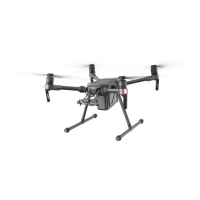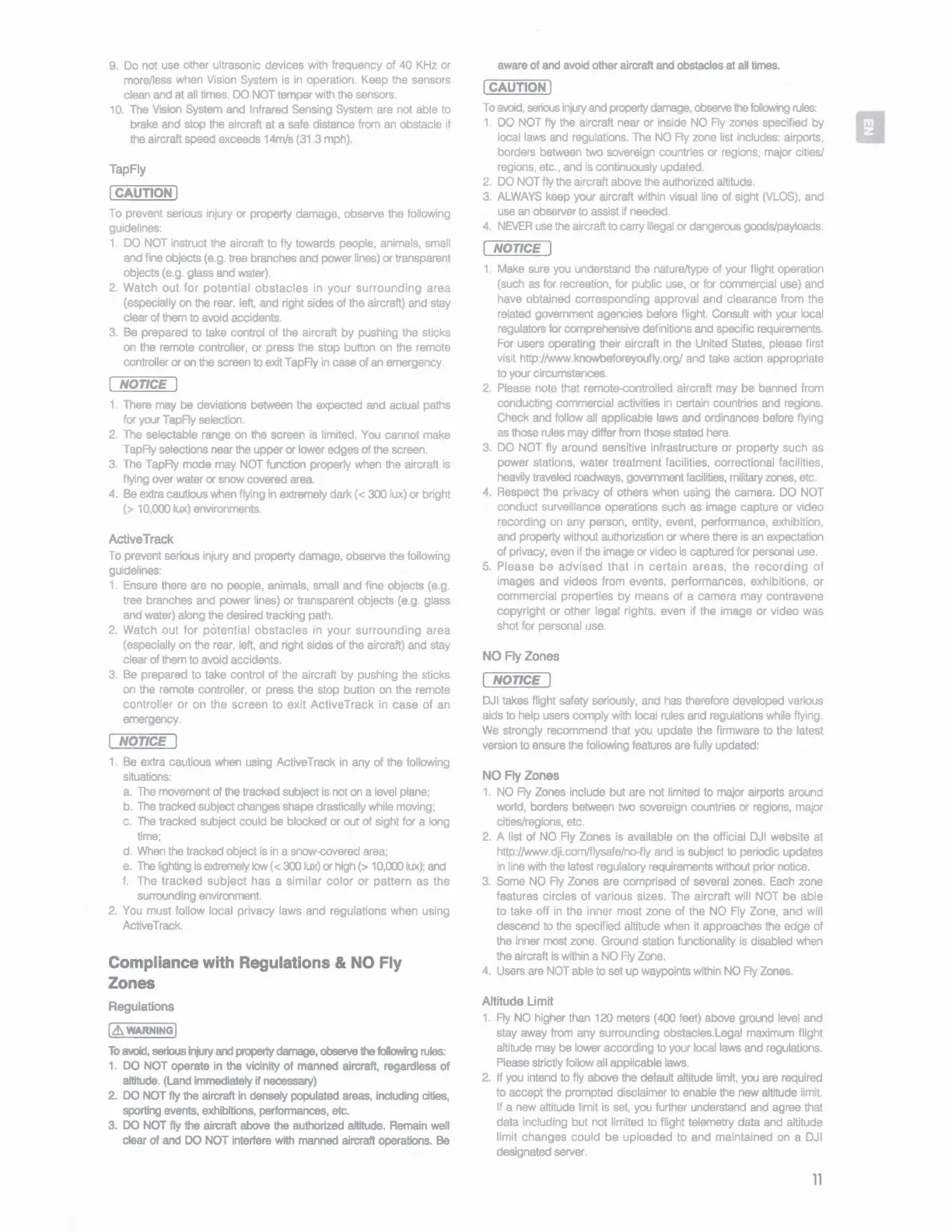9.
Do
not
use
other ultrasonic devices
with
frequency
of
40
KHz
or
more/less
when
Vision
System
is
in
operation. Keep
the
sensors
clean
and
at
all
times.
DO
NOT
temper
with
the
sensors.
10.
The
Vision
System
and Infrared Sensing
System
are
not
able to
brake
and
stop
the
aircraft
at
a
safe
distance
from
an
obstacle
if
the
aircraft speed exceeds
14m/s
(31.3
mph).
TapFly
I CAUTION I
To
prevent serious injury
or
property damage, observe
the
following
guidelines:
1.
DO
NOT
instruct
the
aircraft to fly towards people,
animals,
small
and
fine
objects (e.g.
tree
branches
and
power
lines)
or
transparent
objects (e.g. glass
and
water).
2. Watch out for potential obstacles
in
your surrounding area
(especially
on
the
rear,
left,
and right sides of
the
aircraft) and
stay
clear of
them
to avoid accidents.
3.
Be
prepared to take control of the aircraft by pushing the sticks
on
the
remote
controller,
or
press
the
stop button
on
the
remote
controller
or
on
the screen
to
exit
TapFly
in
case of
an
emergency.
I NOTICE l
1
There
may
be deviations
between
the expected and actual paths
for
yoor
TapFly
selection.
2.
The
selectable range
on
the screen is limited.
You
cannot
make
TapFly
selections
near
the
upper
or
lower edges of
the
screen.
3.
The
TapFly
mode
may
NOT
function properly
when
the
aircraft
is
flying over
water
or
snow
covered
area.
4.
Be
extra
cautious
when
flying
in
extremely dark ( <
300
lux)
or bright
(> 10,000 lux)
environments.
Active Track
To
prevent serious injury
and
property damage, observe
the
following
guidelines:
1.
Ensure
there
are
no
people, animals,
small
and fine objects
(e.g.
tree
branches
and
power
lines)
or
transparent objects
(e.g.
glass
and
water)
along
the
desired tracking
path.
2.
Watch out for potential obstacles
in
your surrounding area
(especially
on
the
rear,
left,
and right sides of
the
aircraft) and
stay
clear of
them
to
avoid
accidents.
3.
Be
prepared to take control of
the
aircraft by pushing
the
sticks
on
the remote controller,
or
press the stop button
on
the
remote
controller or on the screen to exit ActiveTrack
in
case of
an
emergency.
I NOTICE I
Be
extra cautious
when
using ActiveTrack
in
any
of
the
following
situations:
a.
The
movement
of
the
tracked subject
is
not
on
a
level
plane:
b.
The
tracked subject changes shape drastically
while
moving;
c.
The
tracked subject could be blocked
or
out of sight
for
a long
time;
d.
When
the
tracked object
is
in
a snow-covered
area:
e.
The
lighting
is
extremely
low
( <
300
lux)
or
high(>
10,CXX)
lux);
and
f.
The tracked subject has a similar color or pattern
as
the
surrounding
environment.
2.
You
must follow local privacy laws and regulations
when
using
Active
Track.
Compliance with Regulations & NO Fly
Zones
Regulations
l&WARNINGJ
To
avoid,
serious
injury
and
property
damage,
observe
the
following
rules:
1.
DO
NOT
operate
in
the
vicinity of manned
aircraft,
regardless
of
altitude.
(Land
immediately
if
necessary)
2.
DO
NOT
fly
the
aircraft
in
densely
populated
areas,
including
cities,
sporting
events,
exhibitions, perfonnances, etc.
3.
DO
NOT
fly
the
aircraft
above
the
authorized
altitude.
Remain
well
clear of
and
DO
NOT
interfere
with
manned
aircraft
operations.
Be
aware
of
and
avoid
other aircraft and obstacles
at
all
times.
I CAUTION!
To
avoid,
seriCXJs
injury
and
property
damage,
observe the
folbNing
rules:
1
DO
NOT
fly
the
aircraft near or inside
NO
Fly
zones
specified by
local
laws
and
regulations.
The
NO
Fly
zone
list
includes:
airports,
borders
between
two sovereign countries
or
regions,
major
cities/
regions,
etc.,
and
is
continuously updated.
2.
DO
NOT
fly
the
aircraft above
the
authorized
altitude.
3.
ALWAYS
keep
your aircraft
within
visual
line
of
sight
(VLOS).
and
use
an
observer to assist
if
needed.
4.
NEVER
use
the
aircraft
to
carry
illegal
or
dangerous goods/payloads.
I NOTICE I
Make
sure
you
understand
the
nature/type of
your
flight operation
(such
as
for
recreation,
for
public
use,
or for commercial
use)
and
have obtained corresponding approval and clearance from
the
related
government agencies before flight. Consult
with
your
local
regulators
for
comprehensive definitions
and
specific
requirements.
For
users operating their aircraft
in
the United
States,
please first
visit
http://IAWN.knowbeforeyoufly.org/
and
take
action appropriate
to
your circumstances.
2.
Please
note that remote--controlled aircraft
may
be banned
from
conduteting
commercial activities
in
certain countries and
regions.
Check
and
folllow
all
applicable
laws
and ordinances
before
flying
as
those
rules
may differ
from
those
stated
here.
3.
DO
NOT
flly
around sensitive infrastructure or property such
as
power stations, water treatment facilities, correctional facilities,
heavily
traveled
roadways,
government
facilities,
military
zones,
etc.
4.
Respect
the
privacy of others
when
using
the
camera.
DO
NOT
conduct surveillance operations
such
as
image capture or video
recordiing
on
any person, entity, event, performance, exhibition,
and
property without
authorization
or
where
there
is
an
expectation
of privacy,
even
if
the
image or video
is
captured
for
personal
use.
5.
Please
be
advised that in certain areas, the recording of
images and videos from events, performances, exhibitions, or
commercial properties by means of a camera may contravene
copyright or other legal rights, even if
the
image or video was
shot for personal
use.
NO Fly Zones
I NOTICE I
DJI
takes
flight safety
seriously,
and
has
therefore developed
various
aids to help
users
comply
with
local
rules
and
regulations
while
flying.
We
strongly recommend that
you
update the firmware to the latest
version
to
ensure
the
following
features
are
fully updated:
NO
Fly
Zones
1
NO
Fly
Zones
include but
are
not limited
to
major airports around
world,
borders between two sovereign countries
or
regions,
major
cities/regions,
etc.
2.
A list of
NO
Fly
Zones
is
available
on
the official
DJI
website
at
http
:
://www
..
dji.com/flysafe/no-fly
and
is
subject to periodic updates
in
liine
with
the
latest regulatory requirements
without
prior
notice.
3.
Some
NO
Fly
Zones are comprised of
several
zones.
Each
zone
features circles of various sizes.
The
aircraft will
NOT
be able
to take off
in
the inner most zone of the
NO
Fly
Zone,
and will
descend to
the
specified altitude
when
it
approaches
the
edge
of
the
inner
most
zone.
Ground
station
functionality
is
disabled
when
the
aircraft
is
within
a
NO
Fly
Zone.
4.
Users
are
NOT
able to
set
up waypoints
within
NO
Fly
Zones.
Altitude Limit
1,
Fly
NO
higher
than
120
meters
(
400
feet)
above ground
level
and
stay
away
from
any
surrounding obstacles.Legal
maximum
flight
altitude
may
be
lower
according
to
your
local
laws
and
regulations.
Please
strictly follow
all
applicable
laws.
2.
If
you
intend
to
fly above
the
default altitude
limit,
you
are
required
to accept
the
prompted disclaimer to enable
the
new
altitude
iimit.
If a new altitude limit
is
set,
you
further understand
and
agree that
data including but not limited to flight telemetry data and altitude
limiit
changes could be uploaded to and maintained
on
a
DJI
designated
server.
11
El

